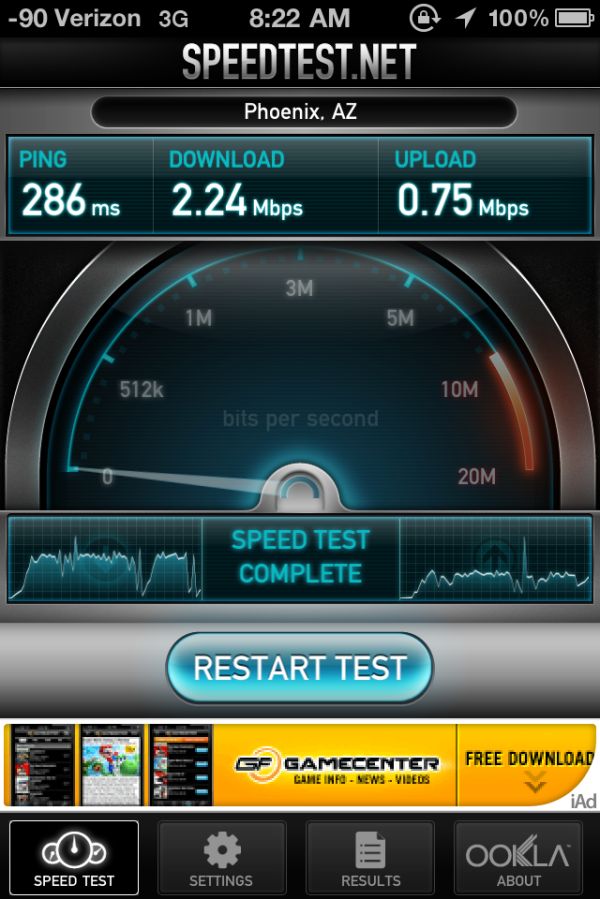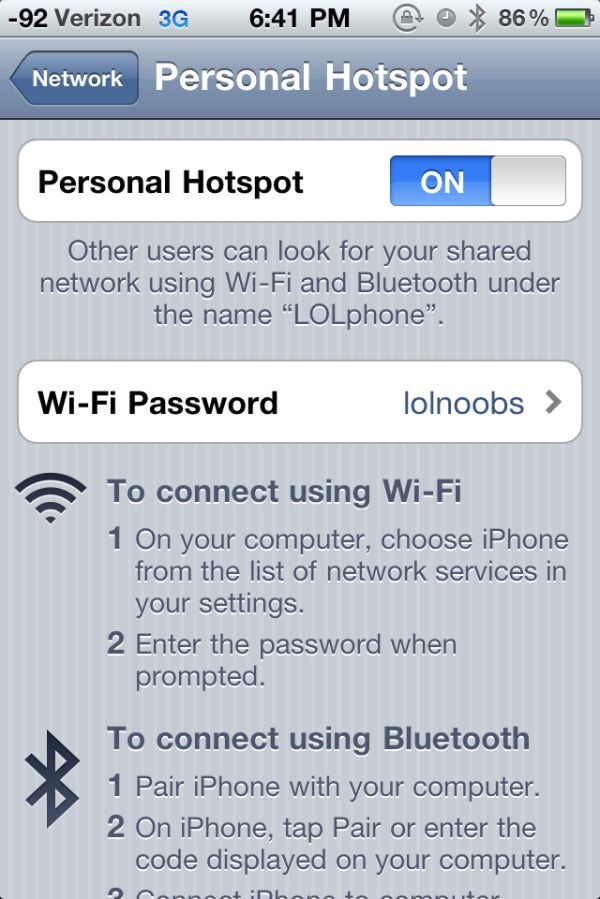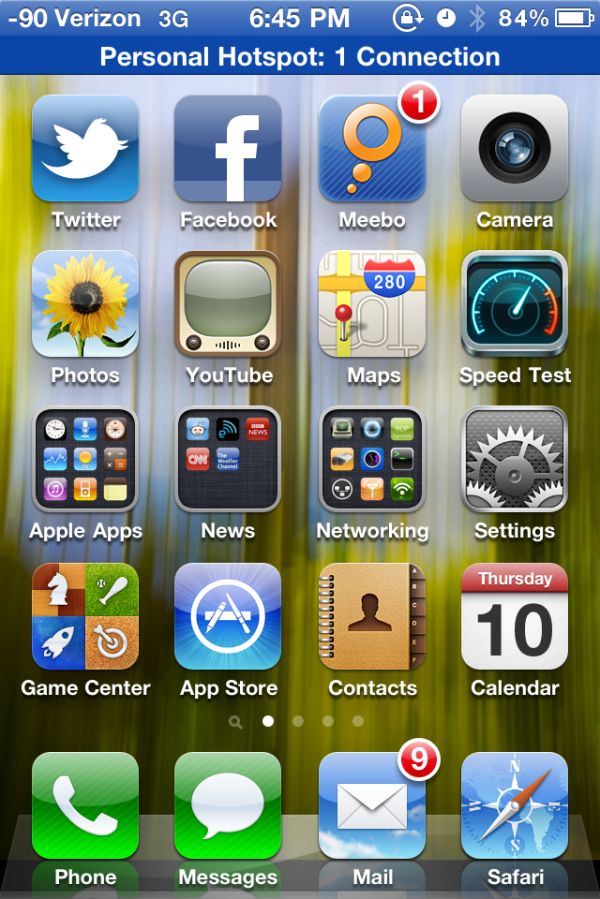Verizon iPhone 4: Thoroughly Reviewed
by Brian Klug on February 13, 2011 9:32 AM ESTData Speed Differences
There's a big difference in both voice quality and speed between the CDMA and UMTS networks in the US. Again, that's one of those huge loaded statements that's subject to a ton of different factors. How loaded cells are, what frequency bands carriers are licensed to use in your market, signal strength, and other factors make it impossible to say definitively which is better.
There's really no sugar coating the reputation that AT&T has gained for having issues in a number of notable metropolises, most of which the carrier claims are fixed. The bigger problem is at conferences, where 3G generally stops responding entirely - I've found myself spending the duration of most on EDGE, where things actually work. In those circumstances, the problem is one of network saturation rather than a technical difference between CDMA2000 and UMTS.
Fastest downstream test I've gotten on the Verizon iPhone
When it comes to data, I've found that EVDO downstream speeds average between 600 and 800 kilobits/s, peaking with the occasional burst up to 2 megabits/s depending on signal quality and load. Upstream speeds sit around 600 kilobits/s with occasional bursts up to around 1 megabits/s. I ran over 230 speedtests using the speedtest.net app on the Verizon iPhone throughout my market all over town. The Verizon iPhone averaged 685 kilobits/s down, 583 kilobits/s up. I saw a maximum downstream rate of 2.24 megabits/s and maximum upstream rate of 1.03 megabits/s. Keep in mind that Verizon's EVDO Rev.A network supports 3.1 megabits/s down and 1.8 megabits/s up per 1.25 MHz channel in theory.
| Device | Verizon iPhone 4 | AT&T iPhone 4 |
| Average Downstream | 0.69 Mbps | 2.03 Mbps |
| Maximum Downstream | 2.24 Mbps | 4.89 Mbps |
| Average Upstream | 0.59 Mbps | 1.08 Mbps |
| Maximum Upstream | 1.03 Mbps | 1.72 Mbps |
I ran the same number of speedtests at the same time and place using the AT&T iPhone 4. In my market, AT&T is allegedly HSDPA 14.4, though I still don't have any devices of the appropriate UMTS class to test and find out. Remember that the iPhone 4 is still a HSPDA 7.2/HSUPA 2.9 device, so it wouldn't make a substantial difference anyhow. I saw an average downstream throughput of 2.02 megabits/s down, 1.08 megabits/s up. Maximum throughput was 4.89 megabits/s down, 1.72 megabits/s up.
I'd say that when it comes to average speed, results like these are pretty typical for comparing Verizon's EVDO Rev.A data to AT&T HSPA data. In pretty average locations (I tested throughout a mall, driving around, in residential, e.t.c.) AT&T is simply faster - there is a tradeoff however. The other consideration is how Verizon's 1xRTT data compares to GSM's GPRS and EDGE. 1xRTT links are 154 kilobits/s up and down, EDGE can be around 200 kilobits/s down, and GPRS is abysmally slow.
Subjectively, the tradeoff between AT&T and Verizon data is one between speed and coverage. While AT&T is much faster close to the cell center, at the edges throughput can suffer substantially. Anecdotally Verizon EVDO throughput seems to be much more uniform throughout the cell, even out at cell edge. Some of my fastest 2 Mbps results on the Verizon iPhone were below -80 dBm.
Personal Hotspot
A huge difference between the two iPhones is the presence of WiFi hotspot functionality. Get the appropriate $20/month add-on, and you can turn the iPhone into a wireless router without having to jailbreak and use something like MyWi.
The hotspot puts you behind a NAT, on 172.20.10.x subnet. Configuration is easy - just toggle it from under network or on the first page of settings, and it'll prompt you that it's about to enable Bluetooth or WiFi appropriately. Configuration options are scant. Encryption always is WPA-PSK, there's no WPA2 or WEP option. The hotspot SSID is also always your phone name, so expect to see lots of "Brad's iPhone" and the cliché "Titanic" AP names pop up at cafes and conferences very soon. Also, the hotspot connects clients at the standard 802.11n rate for 1 spatial stream - 72 Mbps.
When the hotspot is on, you're not actually shown anything. Only when users connect does a blue strip appear just like the green call-in-progress one. Tapping on that brings you immediately into the hotspot settings page. That actually is a bit frustrating if you've got the hotspot going for a friend but want to browse on the phone and use the scroll-to-top gesture.
I've been hammering on the hotspot for a while and have yet to encounter any instability or crashing. Implementation here seems spot-on and stable. Of course, you're still subject to the same simultaneous text/voice and data constraints, but the pause is handled elegantly on clients.
One other notable thing - I'm running iOS 4.3 beta 3 on one of my AT&T iPhone 4s, and noticed that the hotspot logo appears in the place of the WiFi symbol when connected to the Verizon iPhone 4 hotspot. It's the same weird chain-looking symbol. It's very strange that the device can tell it's connected to another iPhone - perhaps a future feature?














35 Comments
View All Comments
shakyone - Sunday, February 13, 2011 - link
Wife got the VZ iPhone 6 days ago. I use an Android phone. After one week, I have yet to experience one dropped call of 23, since it arrived, (used Android's call Log). It is as reliable as her VZ Blackberry. The audio is as good too. My brother has an AT&T iPhone 3GS. I don't talk to him that often, but it has dropped calls on me 3 of the last 7 times I called him in the last four months. I don't have much experience with friends that have the AT&T iPhone 4G.MonkeyPaw - Sunday, February 13, 2011 - link
ATT iPhone 3G user here. I have dropped calls all the time. Doesn't matter where I am. Our other phone is a cheap T-mobile phone, and even with a cheap 2 year old flip phone, calls rarely failed. The worst that happened was poor call quality on occasion.Wiggy McShades - Sunday, February 13, 2011 - link
Where do you live? I'm in the Boston area and have never once had a dropped call using an iphone 3g and now an iphone 4. I'm pretty certain my location is why I've had such a great experience with at&t, are you not near a major city? Or is it really just luck that the area I'm in is well covered?JimmiG - Sunday, February 13, 2011 - link
That really is abysmally slow.. not fast enough to watch video at decent quality, for example. I get around 3500kbps down/1400 up in my apartment on the outskirts of town using the HTC Desire and HSDPA, faster near urban centers.I wouldn't call it a smartphone unless you get at least 2Mb, maybe 1.5Mb/s out of it, since slower speeds render many of the features unusable, limiting you to texting and maybe browsing with images turned off.
dagamer34 - Sunday, February 13, 2011 - link
Some signal is better than no signal at all.Shadowself - Sunday, February 13, 2011 - link
This is *absolutely* true. Some signal is better than none.However, as the article mentions, this is very dependent on the individual. One person may almost never experience dropped calls on AT&T due to where and when they use their phone. In such a situation that person may adamantly prefer the AT&T iPhone over the Verison model. Alternately, another person may use their phone -- even in the same city -- in locals and at times where the phone routinely drops calls due to AT&T's network issues. In this case that user would just as adamantly prefer Verison over AT&T.
My wife's personal experience is that the parking lot of her office is a true Verizon dead zone. There is virtually no detectable signal there at all even with very sophisticated equipment and large antennas. You have to move several hundred yards from her parking lot (in almost any direction) for any Verizon phone to work. Verizon has known about this dead spot for over 8 years and has yet to negotiate a new tower in the area (or modify existing towers) to fill that hole. Therefore, for her Verizon is not an option.
It all comes down to what you need and *your" use.
vol7ron - Sunday, February 13, 2011 - link
Oh no. These Verizon vs AT&T flame-wars are almost worse than the Microsoft vs Apple.At least in the later, you had a constant product difference. In service providers its subject to location. And in major cities, I've never had a problem with AT&T except in metros, where they didn't have antennas and Vzn decided to put some up and large venues where you got a lot of units in one tight area at the same time, like large conferences or concerts.
I've had just as much trouble with Verizon black spots as I've had with AT&T. It's all based on where you are and where you travel.
asandok - Sunday, February 13, 2011 - link
In ifixit's teardown they say the wi-fi antenna is what you point out to be the cell antenna. Which is it? It looks like they made a boo boo. Awesome write up though! Love these!Brian Klug - Monday, February 14, 2011 - link
Indeed, the component they pointed to and called the WiFi antenna is the first of two cellular feed lines, and that part has indeed not changed. It's for cellular (and was on the GSM/UMTS iPhone) and not WiFi. Even the FCC correctly labels it as being a feed line for cellular. WiFi has always been at the top in the same place with the same package, though the WiFi antenna did change slightly with the Verizon version.-Brian
Montrey - Sunday, February 13, 2011 - link
Funny you mention how inaudible the vibrate is. I had my Verizon iPhone on vibrate during a physics test Friday, it rang in the pocket of my jeans and my professor heard it 20 feet away and threatened to kick me out if I didn't turn off my phone. Maybe he just has superhuman hearing, I thought it was pretty quiet, especially compared to the droid eris it just replaced.